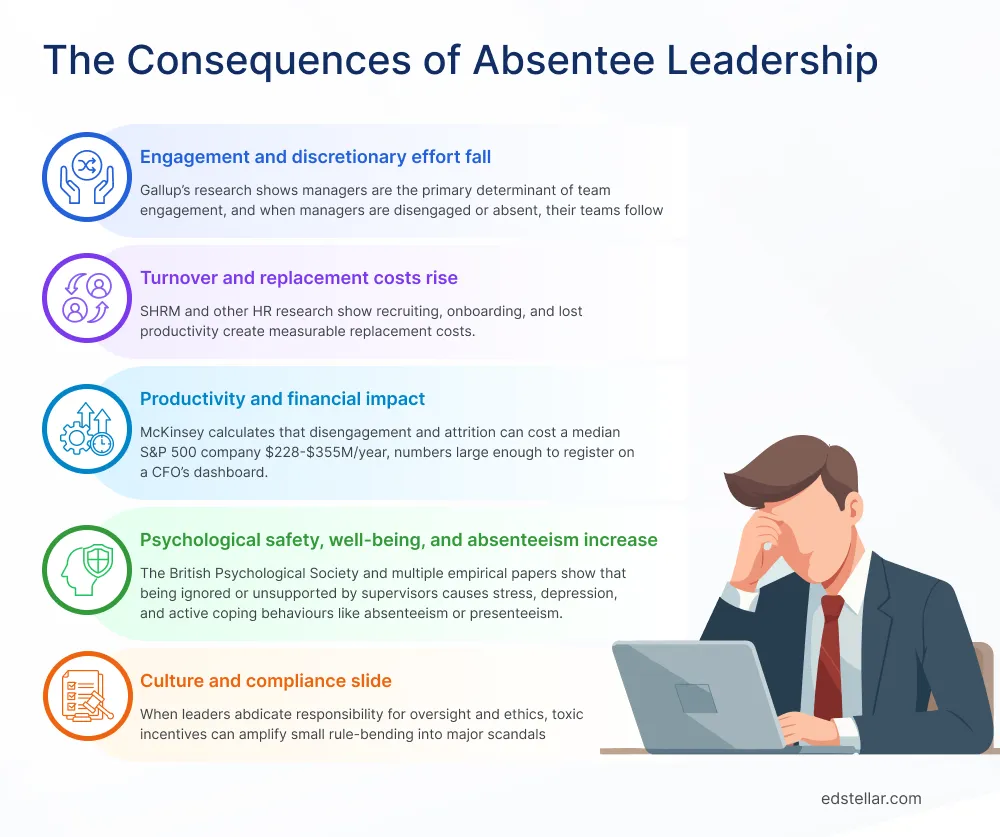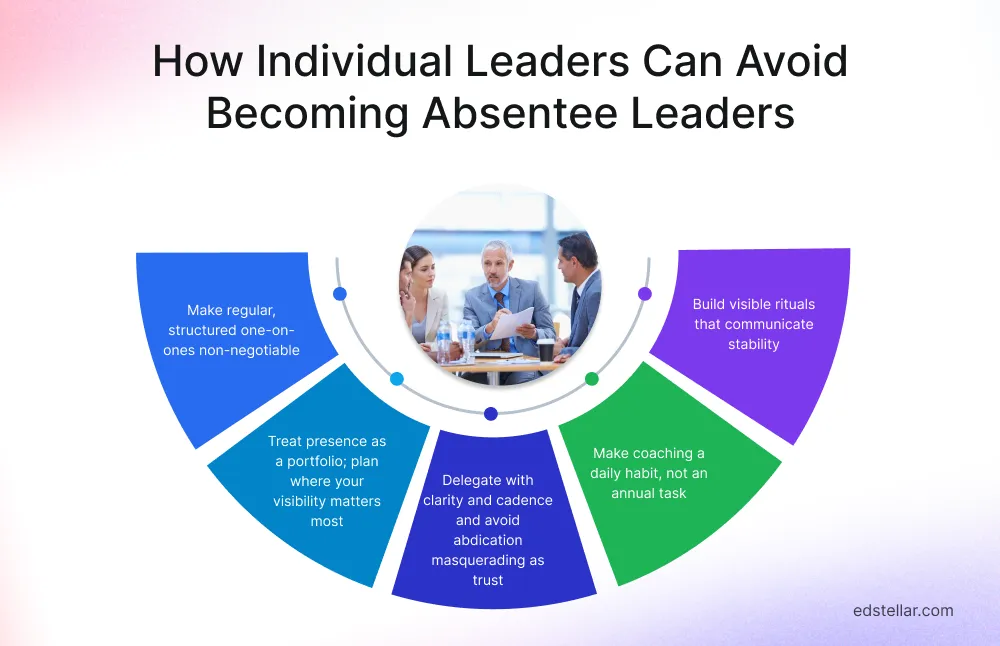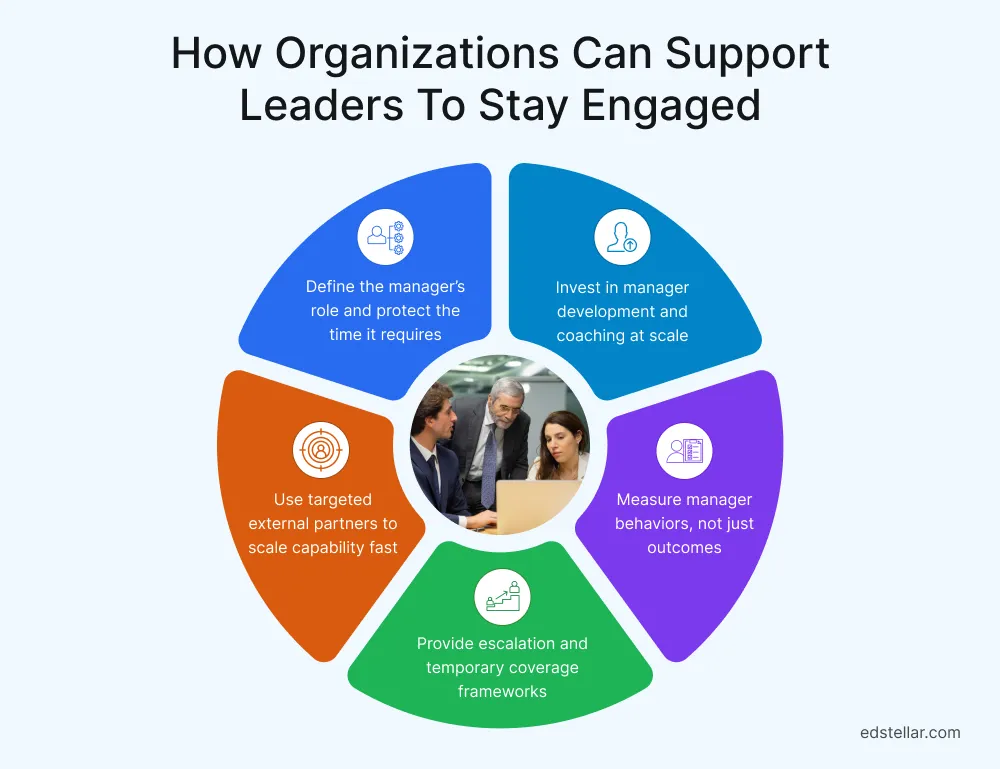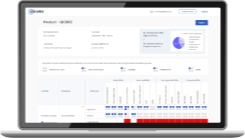
Organizations often treat leadership as a hierarchy of growth, who signs what, and who gets promoted, but leadership is primarily a relational and behavioral lever that either scaffolds performance or lets systems crumble. Three headline findings illustrate how urgently this matters:
- Managers explain the lion’s share of why teams are, or aren’t, engaged. Gallup’s long-running analytics estimate that managers account for about 70% of the variance in team engagement across business units; a single managerial pattern can therefore explain most of the difference between a motivated, productive team and one that is simply treading water.
- Manager engagement is low and getting lower. Gallup’s Global Workplace report found that only 27% of managers were engaged; when the people who should be holding the culture together are themselves checked out, teams suffer in measurable ways.
- The financial cost of disengagement is real and enormous. McKinsey’s work conservatively estimates that employee disengagement and attrition can cost a median-size S&P 500 company between $228 million and $355 million per year in lost productivity, a concrete reminder that leadership behavior is an economic variable, not just a “soft” HR concern.
This blog explores the concept of absentee leadership and how it differs fundamentally from hands-on and hands-off leadership. While hands-on leadership involves close guidance and hands-off leadership empowers teams through trust and autonomy, absentee leadership is marked by disengagement, poor communication, and a lack of support, ultimately leaving teams directionless and demotivated.
What is Absentee Leadership?
Absentee leadership is not simply “not showing up” physically; it’s a pattern of withholding the managerial behaviors teams need: timely decision-making, coaching, clear priorities, follow-through, and protective sponsorship. While the term is often mistakenly used interchangeably with laissez-faire leadership, a style characterized by minimal but intentional intervention, absentee leadership is different. It reflects chronic disengagement, where leaders fail to provide guidance, feedback, or oversight, leaving teams to operate without support or accountability.
It’s crucial to draw a clear line between the three:
- Hands-on leadership involves active involvement, close support, and real-time guidance. It’s ideal for new teams or complex projects needing direction.
- Hands-off (or laissez-faire) leadership means empowering experienced teams with autonomy, while remaining accessible and engaged at a strategic level.
- Absentee leadership is not a leadership style at all; it’s the absence of leadership. The leader is emotionally or physically disengaged, provides no feedback or vision, and fails to support the team, resulting in low morale, confusion, and turnover.
While hands-on and hands-off are intentional approaches that can be effective in the right context, absentee leadership is a failure of responsibility, and no team thrives under neglect.
Viewed through three prisms, behavioral, operational, and psychological, absentee leadership looks like this:
- Behavioral: Irregular or non-existent one-on-ones, little feedback, no coaching, and failure to set or defend priorities; the manager delegates decisions upward or sideways rather than owning them. These behaviors map directly to Gallup’s engagement drivers: consistent coaching by having powerful coaching conversations and frequent developmental conversations.
- Operational: Missing deadlines, unclear ownership, no escalation path when risks appear, and unpredictable availability that forces teams into reactive firefighting and redundant work. Research on role clarity and laissez-faire leadership finds that a lack of clarity mediates many negative outcomes, as employees reveal a lack of support from their manager leads to high strain at work.
- Psychological: Perceived social exclusion, uncertainty, and “who’s steering the ship?” anxiety. The British Psychological Society and workplace studies show that perceived managerial neglect creates stress and erodes psychological safety, the foundation of every learning, innovative team.
Importantly, absentee leadership is systemic: a leader’s absence removes guidance and increases role ambiguity, heightens informal politics, and often causes teams to substitute “visible activity” for real coordination, the hallmark of long-term performance decline.
Passive leadership styles lead to worse engagement, higher withdrawal behaviours (absenteeism and presenteeism), and reduced affective commitment, and laissez-faire leadership relates to negative outcomes of organizational relationships and reputation
The Consequences of Absentee Leadership
Absentee leadership is not just uncomfortable; it is measurable and costly. Below, we reveal the major consequences of absenteeism in leadership and the practical signals you can measure.

1. Engagement and Discretionary Effort Fall
Gallup’s research shows managers are the primary determinant of team engagement, and when managers are disengaged or absent, their teams follow. Engagement matters because it predicts discretionary effort, customer outcomes, and retention; low engagement is not an abstract problem; it is a proximate predictor of missed revenue and innovation. When managers fail to hold routine developmental conversations or fail to give clear performance expectations, team members respond by doing only what is asked (or by quietly checking out.)
2. Turnover and Replacement Costs Rise
When employees can’t find coaching, clarity, or advocacy, they leave: SHRM and other HR research show recruiting, onboarding, and lost productivity create measurable replacement costs. For critical or specialized roles, these costs are high, and they compound when several team members exit over a short period. The “slow drip” of turnover is frequently traceable to managerial absence rather than broad market trends.
And the signs often appear long before resignations hit the desk: decision-making stalls because no one has authority or guidance; escalations go unresolved; project timelines slip due to lack of oversight; and team members grow frustrated by constant prioritization confusion. Over time, this erosion of support and direction makes employees feel isolated and undervalued, pushing even top performers to seek leadership that shows up.
3. Productivity and Financial Impact
McKinsey calculates that disengagement and attrition can cost a median S&P 500 company $228-$355M/year, numbers large enough to register on a CFO’s dashboard. These losses are the aggregated result of slower decision cycles, duplicated work, rework, opportunity cost, and strategic delay.
Absentee leadership directly fuels these inefficiencies: without a leader to clarify priorities, teams duplicate efforts or chase low-impact tasks. Cross-team alignment breaks down, causing delays and miscommunication.
Projects stall not because of a lack of skill, but because no one is present to unblock issues, make calls, or maintain momentum. Over time, these small, repeated breakdowns, missed check-ins, unresolved conflicts, and unclear goals accumulate into material financial losses. Absentee leadership doesn’t just hurt morale; it quietly drains organizational performance from within.
4. Psychological Safety, Well-being, and Absenteeism Increase
The British Psychological Society and multiple empirical papers show that being ignored or unsupported by supervisors causes stress, depression, and active coping behaviours like absenteeism or presenteeism. A clear association between exploitative/passive leadership and higher sickness absence and lower job satisfaction. These are not soft concerns: they feed back into performance and compliance risk (safety incidents, errors, regulatory lapses).
5. Culture and Compliance Slide: Small Absences Can Lead to Serious Consequences
When leaders abdicate responsibility for oversight and ethics, toxic incentives can amplify small rule-bending into major scandals. The Wells Fargo scandal, where aggressive, unmonitored incentives and poor oversight at multiple managerial levels combined to create millions of unauthorized accounts, is a stark example of how leadership absence, blind spots, or deliberate neglect can lead to reputational, regulatory, and financial disaster.
Similarly, the culture crises at Uber exposed how failures to address harassment and poor HR escalation fuelled public blowback and leadership turnover.
These are extreme cases, but they reveal a universal truth: when leaders are absent, accountability fades, norms erode, and risks multiply. Even in less dramatic settings, a lack of visible leadership can weaken psychological safety, reduce compliance vigilance, and allow problematic behaviors to go unchallenged, setting the stage for preventable failures.
Quick reference table: signals that absentee leadership is present
How Individual Leaders Can Avoid Becoming Absentee Leaders
If you’re reading this as a manager and feeling a twinge of recognition, take heart: management presence is a set of habits you can build.

1. Make Regular, Structured One-on-ones Non-negotiable
Research and practitioner guides from HBR show that structured, predictable 1:1s are one of the highest-leverage activities a manager can do: they improve engagement, accelerate problem detection, and enable rapid course corrections. Make the meeting recurring on both calendars, use a short shared agenda (wins, blockers, development, success metrics), and close with concrete action items you both own. A cadence of 30-45 minutes per direct report weekly or biweekly is typical for managers with 5-8 directs.
Practical template:
- Opening (5 min): Personal check-in; one sentence on energy/priority.
- Progress (10-15 min): Recent wins, blockers, and dependencies.
- Development (10 min): One coaching question or skill-building focus.
- Close (5 min): What I will remove; agreed follow-ups.
2. Treat Presence as a Portfolio; Plan Where Your Visibility Matters Most
Leaders cannot be everywhere. The effective strategy isn’t constant presence but targeted presence, intentionally showing up for high-leverage moments (post-mortems, onboarding, performance reviews, conflict resolution, product launches). Clear pre-defined “anchor moments” reduce friction and prevent accidental abdication.
McKinsey’s work on organizational health emphasizes time allocation and role clarity as foundational, since the lower the level of satisfaction and commitment, the lower an employee’s self-reported performance and well-being.
Managers can work alongside HR leaders to carefully map career paths and role responsibilities. This can help guarantee that employees don’t feel trapped in roles without advancement opportunities or in jobs that lack clarity of scope.
3. Delegate with Clarity and Cadence and Avoid Abdication Masquerading as Trust
Delegation is healthy; abdication is not. When you delegate, set the outcome, success metrics, checkpoints, and decision-rights. Add a short “if-this-then-that” escalation clause so your absence doesn’t become a bottleneck. Research into leadership styles finds that explicit follow-up and role clarity mitigate the negative effects of hands-off approaches.
4. Make Coaching a Daily Habit, Not an Annual Task
Gallup and leadership researchers show that coaching raises performance disproportionately to the time invested. Short interventions, like 10-15 minute coaching conversations, recognition in meetings, and rapid feedback, compound faster than long, infrequent interventions. Schedule a weekly “coaching hour” in which you deliberately focus on development conversations.
5. Build Visible Rituals That Communicate Stability
Simple rituals create psychological predictability: a weekly team huddle with a visible agenda, a shared “priority scoreboard,” and a rotating “owner spotlight” reduce ambiguity. Rituals are not bureaucracy; they are the scaffolding that prevents informal, ad-hoc leadership vacuums. Korn Ferry and HBR both recommend such structural routines as low-cost, high-impact interventions to organize, motivate, and direct your team.
How Organizations Can Support Leaders to Stay Engaged
Individual habits are necessary but insufficient when organizational design actively makes the manager’s role impossible. Companies must build systems and measurements into place; otherwise, they ask managers to be heroes rather than professionals.

1. Define the Manager’s Role and Protect the Time It Requires
Too many companies expect managers to both deliver and coach without allocating time for coaching work. Allocate 20-40% of managerial time to people work (development, 1:1s, cross-team coordination), and operationalize this in workload models and performance plans. Without role protection, managers will default to urgent tasks and let people’s work atrophy.
2. Invest in Manager Development and Coaching at Scale
Many managers are promoted for their technical expertise, rather than their leadership or people skills, and are then expected to lead teams without proper training. This gap fuels absentee tendencies, even among well-intentioned leaders.
To close, organizations should implement structured development at scale, starting with a manager onboarding boot camp, reinforced by peer coaching circles and ongoing one-on-one coaching, especially for leaders in critical roles. The evidence from Gallup and Korn Ferry is clear: structured manager development increases manager engagement and downstream team outcomes.
Programs like Edstellar’s Corporate Coaching and Mentoring Training Course offer a proven pathway to build these capabilities. Through instructor-led sessions, practical frameworks, and real-world application, the course equips managers with the skills to coach effectively, provide feedback, and foster a culture of continuous growth. With flexible delivery and content tailored to organizational needs, it supports scalable leadership transformation, not just one-off training.
Consider certification tracks and micro-learning modules so learning fits into the manager’s real calendar.
3. Measure Manager Behaviours, Not Just Outcomes
If you only track delivery KPIs, managers will prioritize output over people, leading to burnout, disengagement, and long-term decline. Instead, add leading indicators of healthy leadership: frequency of 1:1s, quality of development plans, accountability practices, and team pulse scores.
When these behaviors are measured and included in performance reviews, managers are incentivized to lead with empathy, clarity, and consistency.
To support this shift, pair measurement with development. Programs like Edstellar’s Corporate Behavioral Skills Training Courses help managers build the interpersonal and soft skills essential for effective leadership, from active listening and feedback to emotional intelligence and conflict resolution. These instructor-led, enterprise-ready sessions empower managers to meet behavioral expectations and model them, strengthening team trust and organizational culture.
Measure what matters; then equip managers to succeed in it.
4. Provide Escalation and Temporary Coverage Frameworks
A manager legitimately out for an extended period (medical leave, parental leave, travel) should not create a vacuum. Design documented escalation paths, interim coverage rotations, and a “temporary owner pack” (two-page runbook) so the team continues with minimal disruption.
Forbes gives practical checklists for managing leader absence; systemizing these reduces the chance that a temporary absence becomes a chronic leadership deficit. Businesses should implement three key practices:
- Create clear documentation of workflows so teams can operate smoothly in the leader’s absence.
- Share the company’s “why” and its core purpose and values to empower employees to make aligned decisions independently.
- Deliberately take time off to test these systems, allowing teams to practice autonomy and identify gaps.
These steps ensure continuity, build resilience, and reduce dependency on any single leader, enabling the organization to stay on track during unforeseen disruptions.
5. Use Targeted External Partners to Scale Capability Fast
For enterprise programs, combine in-house coaching with trusted external vendors who can scale facilitation and provide objective diagnostics. Vendors like Edstellar offer different price/performance tradeoffs.
Skip the theory; build real leadership behaviors with Edstellar’s practical, instructor-led behavioral training. Edstellar’s comprehensive range of onsite or virtual group courses empowers frontline leaders and teams with the interpersonal and soft skills that drive engagement, accountability, and performance.
Transform how your people lead, connect, and grow; and set the stage for lasting organizational success.
I’ll map these below so you can pick the best fit by budget and cadence.
Organizational interventions & expected benefits (quick table).
Learning Resources
If you need practical vendor recommendations, here’s a mapped set of learning investments with expected outcomes and how to sequence them.
1. Edstellar
What TheyOffer: A catalog of corporate instructor-led programs across Leadership for Managers, People Management, Leading Leaders, High-Impact Leadership, and Decision Making. Course pages show durations, learning objectives, and how programs can be tailored for cohorts.
Why Use Them: Edstellar’s model is practical, modular, and cost-competitive for organizations that need cohort-based instructor-led training with clear topic mapping (e.g., a 4-week manager bootcamp using People Management + Leadership Communication modules).
Good for: fast, cohort-based upskilling and organizations operating globally who want instructor-led delivery.
2. Gallup
What TheyOffer: Gallup’s Manager Program and a range of workplace learning products focused on coaching, strengths, and regular manager interventions.
Why Use Them: Gallup’s work is deeply research-driven and directly tied to engagement metrics; their materials are practical for frontline managers and include certification and train-the-trainer models for internal scale.
Good for: organizations that want a research-backed coaching model tied to engagement measurement.
3. Korn Ferry
What TheyOffer: Comprehensive leadership development, assessment, and high-touch coaching; programs that scale from emerging managers to executives via the Korn Ferry Academy.
Why Use Them: Strong diagnostic instruments and tailored pathways for organizations with mature HR functions; best when you want integrated assessment → development, → coaching.
Good for: mid-to-large firms building long-term leadership pipelines.
Case Study: Wells Fargo: The Cost of Absentee Leadership
Wells Fargo & Company, one of the largest U.S. banks, built a reputation for cross-selling and customer loyalty. By 2016, it had over 265,000 employees and served millions of customers. However, an aggressive sales culture, driven by unrealistic performance targets, began to unravel when reports surfaced of widespread unethical behavior.
The Problem
In 2016, regulators revealed that Wells Fargo employees had opened over 3.5 million unauthorized bank and credit card accounts, without customer consent, to meet sales quotas. Employees created fake email addresses, forged signatures, and enrolled customers in services they didn’t request.
While frontline staff executed these actions, investigations showed the real failure was systemic leadership absence: managers and executives failed to monitor behavior, respond to red flags, or question unsustainable targets.
Root Causes
As per congressional hearings and corporate post-mortems, the crisis was not caused by a few “bad apples,” it was a failure of leadership at multiple levels:
- Toxic Incentives: Employees faced extreme pressure to meet “8 accounts per customer” goals.
- Absentee Oversight: Managers ignored complaints and warning signs; no one held teams accountable ethically, only quantitatively.
- Culture of Fear: Employees feared retaliation for not meeting targets or speaking up.
- Lack of Psychological Safety: HR and compliance channels were ineffective; leadership was disconnected from frontline reality.
- Executive Blind Spots: Top leaders claimed ignorance for years; a sign of deliberate or negligent absenteeism.
Key Insight: This wasn’t hands-off leadership; it was absentee leadership: presence in title, absence in responsibility.
Consequences
The fallout was severe and multi-dimensional:
- Financial: $3 billion in fines and settlements; stock price dropped 40% over 3 years.
- Reputational: Brand trust collapsed; named one of the most hated companies in America.
- Regulatory: Cease-and-desist order from the Federal Reserve; forced to cap asset size.
- Human: 5,300+ employees fired; widespread employee burnout and distrust.
- Leadership Fallout: CEO John Stumpf resigned; board overhauled; long-term leadership instability.
Response & Solutions
Wells Fargo responded with:
- Eliminating cross-selling metrics.
- Overhauling incentive structures.
- Appointing new leadership and ethics officers.
- Launching enterprise-wide culture and compliance training.
- Increasing investment in manager development and internal listening (e.g., pulse surveys).
However, rebuilding trust has taken years, proving that culture recovery is slower than damage creation.
Key Takeaways
- Leadership Presence Matters: Absenteeism, even if unintentional, enables ethical drift.
- Incentives without Oversight Create Risk: What gets measured gets done, but what gets ignored gets abused.
- Frontline Managers are Culture Carriers: They must be trained, supported, and held accountable.
- Silence is not Consent: Leaders must actively listen, engage, and intervene.
- Healthy Hands-off Leadership ≠ Absenteeism: The former empowers, the latter abandons.
Final Lesson: You don’t need to be present to cause harm; absence itself can be a leadership decision with catastrophic consequences.
The Bottom Line
Absentee leadership is a practical problem with measurable costs: disengaged managers depress engagement, raise turnover, and create operational and reputational risk. The good news is that reversing it is straightforward in principle and high-ROI in practice: protect managers’ time for people work, measure and reward behavior as well as delivery, and run a focused bootcamp + coaching program to raise baseline competence.
For scalable, high-impact development, consider Edstellar, a one-stop, instructor-led corporate training and coaching platform that delivers over 2,000 tailored programs globally. With offerings in Leadership, Behavioral Skills, Management, Compliance, and Social Impact, Edstellar combines expert-led sessions with tools like Skill Matrix to drive talent transformation.
Schedule a demo today and empower your managers with the skills they need to lead with presence, purpose, and impact.
Explore High-impact instructor-led training for your teams.
#On-site #Virtual #GroupTraining #Customized

Bridge the Gap Between Learning & Performance
Turn Your Training Programs Into Revenue Drivers.
Schedule a ConsultationEdstellar Training Catalog
Explore 2000+ industry ready instructor-led training programs.

Coaching that Unlocks Potential
Create dynamic leaders and cohesive teams. Learn more now!


Want to evaluate your team’s skill gaps?
Do a quick Skill gap analysis with Edstellar’s Free Skill Matrix tool

Transform Your L&D Strategy Today
Unlock premium resources, tools, and frameworks designed for HR and learning professionals. Our L&D Hub gives you everything needed to elevate your organization's training approach.
Access L&D Hub Resources.svg)
.svg)



.svg)

.webp)
.svg)
.svg)
.svg)
.svg)

